
 Roni Essex
Freediver, Spearo, Creator
Roni Essex
Freediver, Spearo, Creator

 Roni Essex
Freediver, Spearo, Creator
Roni Essex
Freediver, Spearo, Creator
Nestled in the azure expanses of the Indian and Pacific Oceans, the dogtooth tuna emerges as a majestic creature, captivating both seasoned spearos and marine enthusiasts alike. From its distinctive appearance to its prowess as an apex predator, this species, scientifically known as Gymnosarda unicolor, stands as a testament to the wonders that thrive beneath the ocean's surface.
At the heart of the dogtooth tuna's allure lies its extraordinary anatomy. The tuna's streamlined body is a masterpiece of aquatic engineering, designed for swift navigation and precise maneuvering. Its sleek contours not only contribute to its agility but also serve as a visual symphony of efficiency, capturing the essence of underwater grace.
A defining feature that distinguishes the dogtooth tuna from its marine counterparts is its formidable set of teeth, akin to those of a canine. These elongated, razor-sharp dentitions are not merely an aesthetic quirk but rather a functional adaptation crafted by nature. The purpose of these teeth goes beyond mere aesthetics; they are instrumental in the tuna's predatory pursuits. Like underwater daggers, these teeth are expertly crafted tools for seizing and subduing prey in the vast expanse of the ocean.
The dogtooth tuna's coloration adds another layer to its visual splendor. Often displaying a metallic sheen ranging from silver to bronze, their bodies shimmer with the hues of their watery realm. This adaptive coloration serves not only as a visual spectacle for onlookers but also as a strategic camouflage, allowing them to blend seamlessly into the play of light and shadows beneath the ocean's surface.
The tuna's fins, finely tuned for precision and control, are yet another marvel of adaptation. The dorsal and anal fins are elongated, enhancing their stability in the water and aiding in rapid acceleration—a crucial trait for a predator navigating the vast expanses of the open ocean.
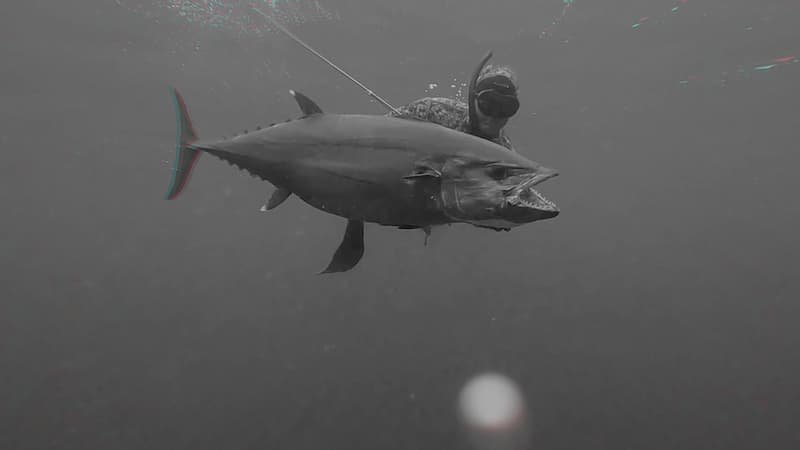
Scaling lengths that surpass the 6-foot mark (1.8 meters), these aquatic giants command attention with their sheer size, dwarfing many of their marine counterparts. But it's not just about length; it's about the weight that these creatures bear, with individuals tipping the scales at over 220 pounds (100 kilograms). Such remarkable dimensions catapult the dogtooth tuna into the upper echelons of the ocean's hierarchy.
The enormity of the dogtooth tuna is not merely a spectacle for the eyes; it holds profound implications for the ecological dynamics of the marine ecosystems it inhabits. As a formidable predator, its size positions it as a keystone species, influencing the abundance and behavior of prey species in its domain. The ecological footprint of such a colossal tuna resonates through the underwater food web, shaping the delicate balance that defines life beneath the surface.
For spearos, the pursuit of dogtooth tuna becomes a quest for the extraordinary. The challenge lies not just in the technical skill required to engage with such a powerful and massive fish but also in the sheer awe inspired by the opportunity to encounter a creature of such immense proportions. The trophy value of a dogtooth tuna is not measured solely in pounds but in the magnitude of the experience—an encounter with a true leviathan of the open seas.
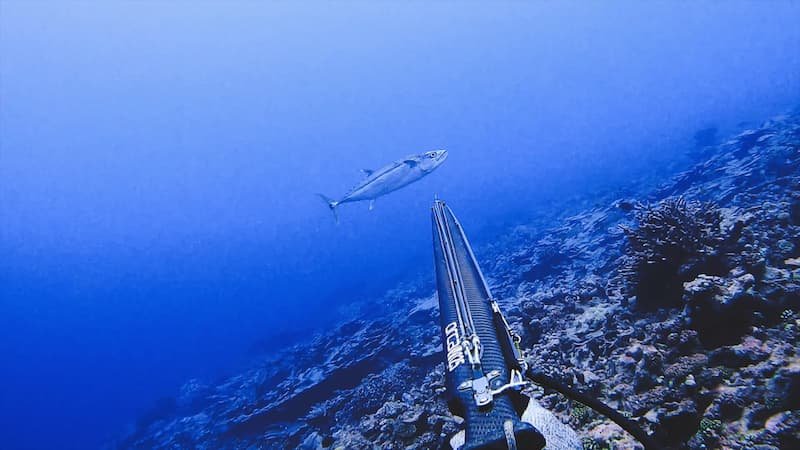
Venture into the warm embrace of tropical and subtropical waters, and you'll likely find the dogtooth tuna weaving through the aquatic tapestry, a master of its domain. This species has an affinity for the idyllic realms of the Indian and Pacific Oceans, where the waters teem with life, and vibrant coral reefs create a mesmerizing backdrop. It's here, in these sun-kissed expanses, that the dogtooth tuna finds both sustenance and sanctuary.
Navigating the open waters near coral reefs, islands, and continental shelves, the dogtooth tuna makes strategic use of its surroundings. Coral reefs, with their intricate structures and abundance of marine life, serve as both hunting grounds and refuge for these majestic fish. The interplay of currents and the dynamic underwater landscape offer a rich mosaic of environments, providing ample opportunities for the tuna to showcase its adaptability and hunting prowess.
The tropical haven is not merely a geographical preference for the dogtooth tuna; it's a manifestation of the species' ecological role. These waters, with their optimal temperature and abundant prey, create a perfect storm for the tuna's thriving existence. The symbiotic relationship between the dogtooth tuna and its tropical habitat is a delicate dance, a harmony between the creature and the environment that has sculpted the evolution of both.
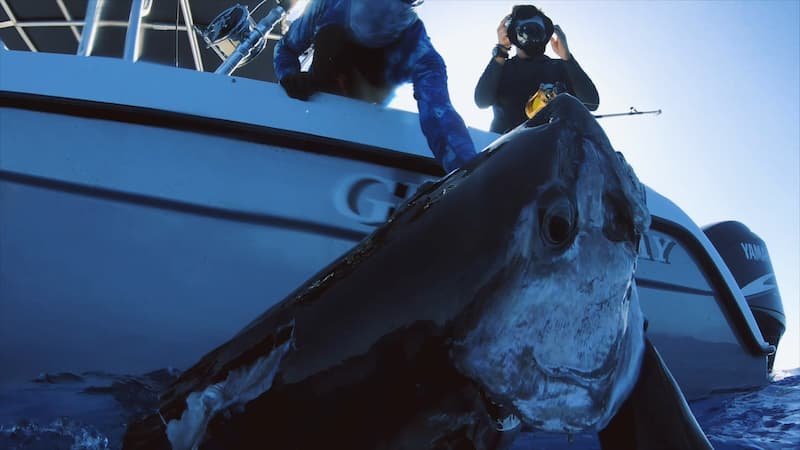
Beneath the sunlit waves, the dogtooth tuna emerges as a paragon of aquatic prowess, an agile swimmer seamlessly blending power and grace. Renowned as one of the fastest fish in the ocean, the dogtooth tuna navigates the open waters with a proficiency that befits its status as an apex predator. Its speed is not just a product of muscle and fin; it is a testament to the evolutionary arms race that has shaped this species into a formidable force.
Schooling in coordinated formations, dogtooth tuna become a synchronized ballet of aquatic excellence. The agility of their movements is not a mere spectacle but a strategic advantage, allowing them to pursue and outmaneuver prey with remarkable precision. The open ocean becomes their hunting ground, a vast expanse where their speed becomes both a means of survival and a tool for securing sustenance.
At the heart of their predatory success lies a set of teeth that can only be described as nature's weaponry. The sharp, elongated teeth are not just for show; they are finely honed instruments of capture. In the blink of an eye, the dogtooth tuna can seize and subdue prey, its teeth serving as a lethal extension of its hunting strategy. This predatory prowess places the dogtooth tuna at the top of the oceanic food chain, a true master of the art of predation.
Their menu is diverse, reflecting the adaptability of an apex predator. Smaller fish, squid, and crustaceans all fall within the crosshairs of the dogtooth tuna's voracious appetite. The delicate dance between predator and prey becomes a symphony of life beneath the waves, an intricate web where the survival of one species hinges on the predatory instincts of another.
For marine enthusiasts and scientists alike, the behavior of dogtooth tuna in their natural habitat is a subject of fascination. The study of their hunting strategies, social dynamics within schools, and the ecological impact of their predatory role unveils a deeper understanding of the intricacies of marine ecosystems. The agile swimmers and apex predators that are dogtooth tuna embody the raw beauty and complexity of nature's evolutionary tapestry, a tapestry woven through the dance of life and death in the vastness of the open ocean.
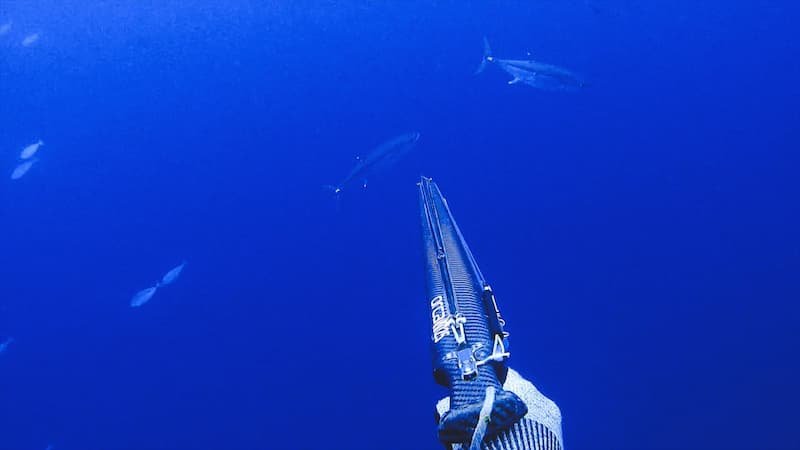
Within the vast expanse of the open seas, the dogtooth tuna reigns as a consummate predator, and its feeding habits unveil a narrative of precision, strategy, and the unrelenting pursuit of sustenance. As an apex predator, the dogtooth tuna is not merely a passive participant in the marine food web; it is a master strategist, adapting its feeding habits to exploit the rich tapestry of life that inhabits the ocean depths.
A primary component of the dogtooth tuna's diet is the smaller fish that populate its realm. With a hunting strategy characterized by both patience and explosive bursts of speed, the tuna zeroes in on schools of smaller fish, utilizing its streamlined form and unparalleled agility to cut through the water with finesse. The pursuit becomes a ballet of aquatic precision, a choreography of swift maneuvers that culminates in the calculated strike, where the tuna's sharp teeth serve as the final instrument of capture.
Beyond fish, the dogtooth tuna extends its culinary preferences to include squid and crustaceans. These agile predators showcase remarkable adaptability in their feeding habits, adjusting their strategies based on the availability and behavior of different prey species. The oceanic pantry becomes a diverse menu from which the dogtooth tuna selects its sustenance, showcasing a flexibility that underscores its position as a top-tier predator.
A key element of the dogtooth tuna's feeding behavior is the utilization of its keen senses. Vision, honed in the crystal-clear waters of its tropical habitat, allows the tuna to spot prey from considerable distances. The lateral line, a sensory organ sensitive to water movements, aids in detecting the subtlest ripples created by potential prey. These acute senses, coupled with the tuna's speed, transform the open ocean into a realm where the slightest advantage can tip the scales in favor of the hunter.
The feeding habits of the dogtooth tuna, therefore, become a symphony of adaptation and strategy. It is a dance of predator and prey, where each movement, each burst of acceleration, and each strike is a finely tuned expression of the tuna's role in the perpetual cycle of life and death beneath the waves. As we unravel the intricacies of their feeding habits, we gain insight into the delicate equilibrium that defines the oceanic ecosystem—a balance that hinges on the predatory prowess of creatures like the dogtooth tuna.
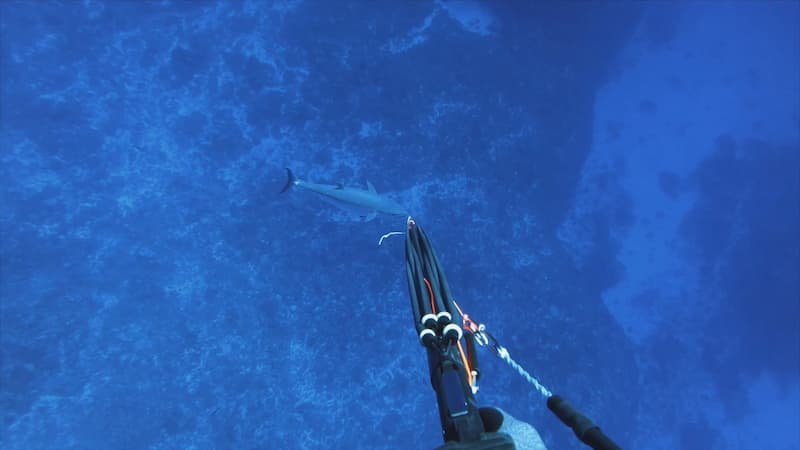
Amid the splendor of the open seas, the dogtooth tuna exists as a charismatic giant, but its magnificence is tinged with concerns about its conservation status. While the dogtooth tuna's individual conservation status is not distinctly assessed, the species, like many large pelagic predators, grapples with the looming threats of overfishing, habitat degradation, and the ever-expanding footprint of human activities in marine environments.
One of the primary challenges confronting the conservation of dogtooth tuna is the relentless pressure from commercial fisheries. Their prized meat, esteemed for its quality, makes the tuna a lucrative target. Overfishing, fueled by high demand, poses a serious risk to the sustainability of dogtooth tuna populations. As fishing technologies advance, the need for stringent management measures becomes paramount to prevent depletion and maintain a delicate ecological balance.
Habitat degradation further compounds the challenges faced by dogtooth tuna. Climate change, driven by human activities, induces alterations in oceanic temperatures and currents, impacting the distribution of prey species and influencing the migratory patterns of the tuna. Coral reefs, integral to the tropical havens frequented by these giants, face bleaching and degradation, stripping away crucial habitats and exacerbating the vulnerability of the species.
Conservation initiatives, therefore, emerge as a critical lifeline for the dogtooth tuna. Collaborative efforts between governments, conservation organizations, and the fishing industry are essential to implement and enforce sustainable fishing practices. These practices encompass strategies such as setting catch limits, establishing protected marine areas, and promoting responsible fishing methods that reduce bycatch and minimize the impact on the tuna population.
Scientific research plays a pivotal role in informing conservation strategies. Studying the migratory patterns, reproductive behaviors, and population dynamics of dogtooth tuna enables scientists to formulate effective conservation measures. Satellite tracking, acoustic tagging, and genetic studies contribute valuable data, aiding in the development of management plans that ensure the long-term viability of the species.
Educational outreach and public awareness campaigns also form integral components of dogtooth tuna conservation. By fostering an understanding of the ecological importance of these apex predators and the broader marine ecosystem, such initiatives seek to instill a sense of responsibility and stewardship among communities, encouraging sustainable practices and the preservation of oceanic biodiversity.

Beyond the realms of the open seas and spearfishing adventures, the dogtooth tuna transitions from a marine marvel to a culinary delight that graces the tables of connoisseurs across the globe. Its firm, succulent flesh, rich in flavor and prized for its exquisite texture, elevates the dogtooth tuna to a culinary status that transcends the boundaries of traditional seafood appreciation.
The journey from the ocean depths to the dining table is a testament to the artistry of culinary craftsmanship. Chefs, renowned for their expertise in handling delicate flavors and textures, have embraced the dogtooth tuna as a canvas for their gastronomic creations. The sushi and sashimi culture, deeply rooted in Japanese culinary traditions, places the dogtooth tuna on a pedestal, allowing enthusiasts to savor its raw, unadulterated essence.
The firmness of the dogtooth tuna's flesh makes it an ideal candidate for a myriad of culinary applications. Whether seared to perfection, thinly sliced for sashimi, or crafted into delectable sushi rolls, the versatility of this fish lends itself to a spectrum of culinary possibilities. Its inherent richness, coupled with a mild yet distinctive flavor, allows chefs to explore various cooking techniques, resulting in dishes that captivate the palate.
The culinary journey of the dogtooth tuna extends beyond traditional Japanese cuisine. In coastal regions where the fish is caught, it finds its way into local delicacies, reflecting the diverse culinary tapestry woven by communities living in harmony with the sea. Grilled, smoked, or incorporated into hearty stews, the dogtooth tuna becomes a centerpiece, celebrating the bounty of the ocean and the culinary heritage of coastal cultures.
The popularity of dogtooth tuna in haute cuisine circles underscores its place as a premium ingredient. Culinary enthusiasts seek out dining experiences that showcase the fish's natural flavors, often paired with complementary ingredients that accentuate its unique profile. As the appreciation for sustainable and responsibly sourced seafood grows, the dogtooth tuna becomes not just a delicacy but a symbol of conscientious dining—an embodiment of the delicate balance between culinary indulgence and environmental stewardship.
Yet, with the growing demand for dogtooth tuna in gastronomic circles, the importance of responsible sourcing cannot be overstated. Sustainable fishing practices, traceability in the supply chain, and adherence to conservation guidelines become integral to ensuring that the culinary delight derived from this majestic fish remains a sustainable pleasure for generations to come.
In essence, the dogtooth tuna, transitioning from the depths of the ocean to the heights of culinary excellence, weaves a narrative that connects the marine world to the dining experience. Its culinary allure, celebrated in kitchens around the world, invites us to savor not just the flavors of the sea but also to embrace a responsibility to protect the oceans and the species that contribute to the tapestry of our gastronomic pleasures.